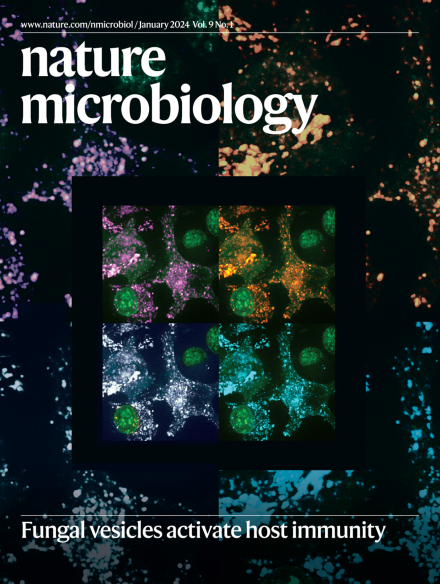宿主导向的佐剂使细胞内细菌对抗生素致敏。
IF 19.4
1区 生物学
Q1 MICROBIOLOGY
引用次数: 0
摘要
细胞内细菌储存库通过培养代谢休眠的持久性细胞而导致抗生素治疗失败,这些细胞对杀伤具有高度耐受性。然而,有效靶向细胞内持久性细胞的策略仍然有限。在这里,我们开发了一种高通量筛选来鉴定调节细胞内金黄色葡萄球菌代谢活性的化合物。鉴定的化合物KL1增加了细胞内细菌代谢活性,使金黄色葡萄球菌对抗生素敏感,而不会引起细胞毒性或细菌生长。KL1对巨噬细胞内肠炎沙门氏菌、鼠伤寒沙门氏菌和结核分枝杆菌,以及金黄色葡萄球菌和鼠伤寒沙门氏菌感染的小鼠感染模型也表现出佐剂活性。转录组学分析和进一步的机制研究表明,KL1调节宿主免疫应答基因,抑制宿主巨噬细胞中反应性物质的产生,减轻抗生素耐受的关键诱导剂。我们的发现强调了通过刺激细胞内持久性细胞的代谢来靶向它们的潜力。在抗菌化疗领域存在两大问题:抗生素耐药和抗生素耐受。抗生素耐受性经常与临床治疗效果差有关。与抗生素耐药性不同,抗生素耐药性允许细菌在药物存在的情况下生长,抗生素耐受性允许细菌长时间承受多种抗生素。随着时间的推移,耐药细菌的生存时间延长,进一步使它们容易进化出抗生素耐药性,这强调了解决抗生素耐药问题的迫切需要。宿主相互作用已被证明可诱导许多病原体的持久性形成,活性氧和活性氮的产生与细菌代谢活性的崩溃和进入抗生素耐受状态密切相关。然而,研究或瞄准这一过程的工具仍然有限。在这里,我们开发了一种高通量筛选方法来鉴定调节细胞内金黄色葡萄球菌代谢的化合物,从而发现了KL1,这是一种宿主导向的化合物,可使持久菌对抗生素杀伤敏感。本文章由计算机程序翻译,如有差异,请以英文原文为准。
A host-directed adjuvant sensitizes intracellular bacterial persisters to antibiotics.
Intracellular bacterial reservoirs contribute to antibiotic treatment failure by fostering metabolically dormant persister cells that are highly tolerant to killing. However, strategies to effectively target intracellular persister cells remain limited. Here we developed a high-throughput screen to identify compounds that modulate the metabolic activity of intracellular Staphylococcus aureus. The identified compound, KL1, increases intracellular bacterial metabolic activity and sensitizes persister populations of S. aureus to antibiotics, without causing cytotoxicity or bacterial outgrowth. KL1 also exhibits adjuvant activity against intramacrophage Salmonella enterica Typhimurium and Mycobacterium tuberculosis, as well as in murine infection models of S. aureus and S. Typhimurium infection. Transcriptomic analysis and further mechanistic studies reveal that KL1 modulates host immune response genes and suppresses the production of reactive species in host macrophages, alleviating a key inducer of antibiotic tolerance. Our findings highlight the potential to target intracellular persisters by stimulating their metabolism. There are two major problems in the field of antimicrobial chemotherapy-antibiotic resistance and antibiotic tolerance. Antibiotic tolerance has been frequently connected with poor treatment outcomes in the clinic. Unlike antibiotic resistance, which permits bacterial growth in the presence of drugs, antibiotic tolerance allows bacteria to withstand multiple antibiotics for prolonged periods. The extended survival of tolerant bacteria further predisposes them to evolve antibiotic resistance over time, underscoring the critical need to address antibiotic tolerance. Host interactions have been shown to induce persister formation in numerous pathogens, with the production of reactive oxygen and nitrogen species heavily implicated in the collapse of bacterial metabolic activity and entry into an antibiotic-tolerant state. Yet, tools to study or target this process remain limited. Here we developed a high-throughput screen to identify compounds that modulate intracellular S. aureus metabolism, leading to the discovery of KL1, a host-directed compound that sensitizes persisters to antibiotic killing.
求助全文
通过发布文献求助,成功后即可免费获取论文全文。
去求助
来源期刊

Nature Microbiology
Immunology and Microbiology-Microbiology
CiteScore
44.40
自引率
1.10%
发文量
226
期刊介绍:
Nature Microbiology aims to cover a comprehensive range of topics related to microorganisms. This includes:
Evolution: The journal is interested in exploring the evolutionary aspects of microorganisms. This may include research on their genetic diversity, adaptation, and speciation over time.
Physiology and cell biology: Nature Microbiology seeks to understand the functions and characteristics of microorganisms at the cellular and physiological levels. This may involve studying their metabolism, growth patterns, and cellular processes.
Interactions: The journal focuses on the interactions microorganisms have with each other, as well as their interactions with hosts or the environment. This encompasses investigations into microbial communities, symbiotic relationships, and microbial responses to different environments.
Societal significance: Nature Microbiology recognizes the societal impact of microorganisms and welcomes studies that explore their practical applications. This may include research on microbial diseases, biotechnology, or environmental remediation.
In summary, Nature Microbiology is interested in research related to the evolution, physiology and cell biology of microorganisms, their interactions, and their societal relevance.
 求助内容:
求助内容: 应助结果提醒方式:
应助结果提醒方式:


